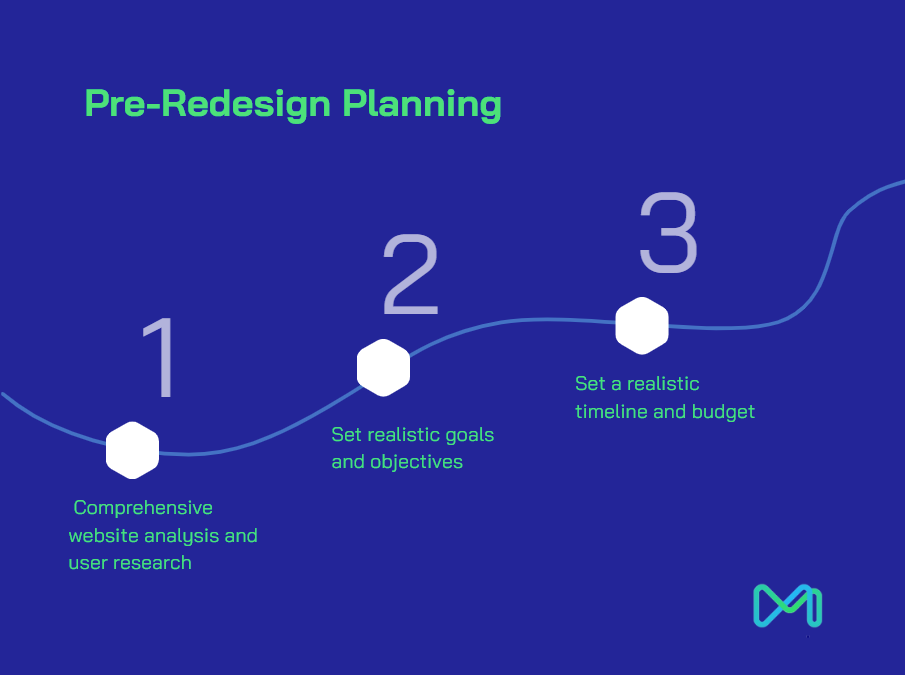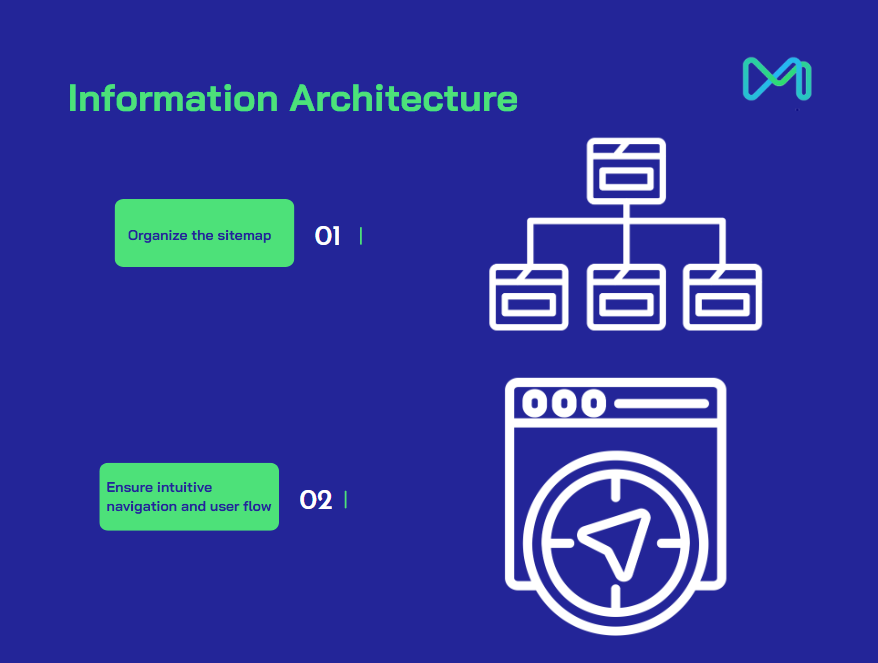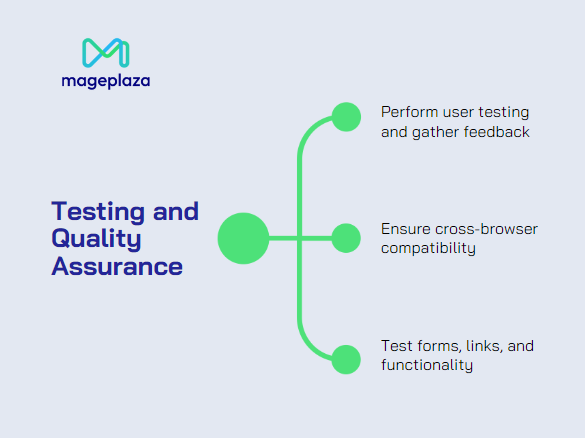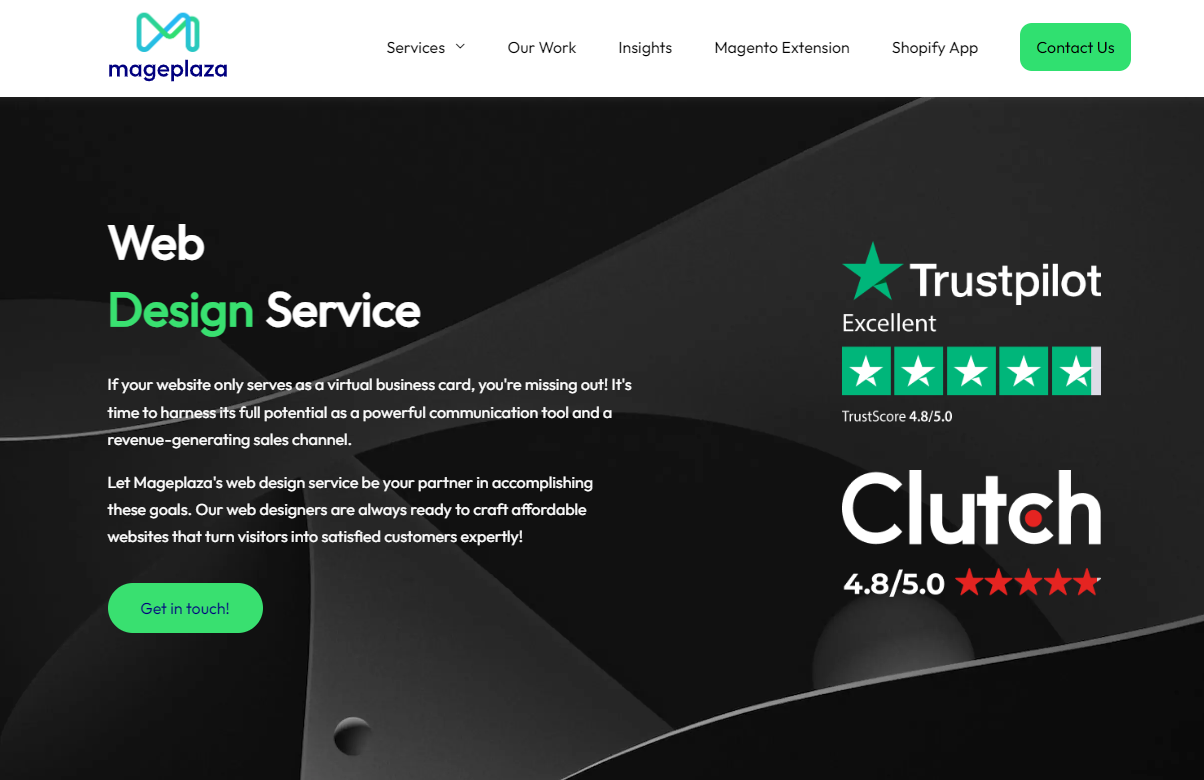Website Redesign Checklist: Easy-to-Apply [with PDF template]
Summer Nguyen | 09-16-2024
![Website Redesign Checklist: Easy-to-Apply [with PDF template] - Mageplaza](https://storage.googleapis.com/mageplaza.com/media/2024/09/05143938/website-redesign-checklist.jpg)
Are you thinking about redesigning your website? That’s fantastic! But we understand all the steps involved can seem overwhelming. This is where our website redesign checklist saves the day.
You can consider it your reliable guide through every step of the redesign process, from brainstorming ideas to the big reveal. We’ve gone beyond the surface, offering actionable advice to make your new website visually stunning and incredibly user-friendly. Check it out now!
Website Redesign: Download Free Checklist and Working Templates

Website Redesign Checklist
This comprehensive website redesign checklist will walk you through each phase, including:
Pre-Redesign Planning
Before diving into the design and development phases, laying a solid foundation for your project is essential. This initial step focuses on:

1. Comprehensive website analysis and user research
To kickstart your website redesign, begin by thoroughly analyzing your site. You should access three aspects:
- Website performance: To assess website performance, use Google Analytics 4 (GA4) for traffic sources, engagement, and bounce rate insights. Hotjar provides heatmaps and session recordings for user behavior analysis. SEMrush helps monitor page load speed and mobile responsiveness, while Google Search Console tracks search performance and identifies mobile usability issues.
- Technical SEO Audit: Conduct an SEO audit using tools like Ahrefs or Screaming Frog. Identify technical issues like broken links, missing meta tags, or duplicate content that could hinder your site’s search engine ranking. For instance, if multiple pages are missing meta descriptions, update them with keyword-rich content to improve click-through rates from search engine results.
- Gather user feedback: Conduct user research through surveys, interviews, and tools like UserTesting or Lookback to gain insights into user experiences and challenges. For instance, if users frequently mention difficulty navigating your site during interviews, it’s a sign that your navigation needs revamping. Complemented by heatmaps and session recordings, this qualitative data will guide the redesign to better meet user needs.
- Evaluating key competitors: Study your competitors’ websites to understand their strengths and weaknesses, particularly in design trends, innovative features, and user experience elements. Use tools like SimilarWeb to compare traffic sources and SEO performance. For example, if a competitor ranks higher for key terms, analyze their content structure and backlink profile to find opportunities for improvement.
Once you’ve analyzed all the gathered data, compile a summary table outlining specific, actionable improvements and enhancements for your website redesign. This benchmark table will serve as a roadmap, helping you set clear, realistic goals, establish an accurate budget, and create a feasible timeline.
2. Set realistic goals and objectives
Next on the website redesign checklist is setting clear, realistic goals and objectives. It’s crucial to have everyone on the same page, working towards a common purpose. To do this effectively, consider using the SMART Goals model. This approach helps you create goals that are specific, measurable, achievable, relevant, and time-bound.
For example, you might aim to “Increase conversion rates by 15% within six months,” “Reduce bounce rate by 10%,” or “Enhance mobile usability to achieve a 90% satisfaction rating in user surveys.” These goals will keep your redesign focused and purposeful.
3. Set a realistic timeline and budget
Lastly, on your pre-redesign planning checklist, you should set a realistic timeline and budget. This step is crucial for keeping your project on track and within financial constraints.
Start by breaking down the redesign into phases and setting milestones for each. This approach will help you monitor progress and ensure the project stays on schedule. Remember to account for all costs associated with the redesign, including design, development, content creation, and testing.
It’s also wise to include extra time in your timeline for unforeseen delays or challenges. This flexibility will help you avoid rushing and make sure the final product meets your quality standards
Information Architecture
A well-organized and intuitive information architecture (IA) is crucial for a positive user experience and SEO. A clear structure guides users seamlessly through your website, making it easy for them to find the information they need and for search engines to crawl and index your content.

1. Organize the sitemap
The first task in this phase of your website redesign checklist is to organize your sitemap. A detailed sitemap should outline your new website structure, including all main pages and subpages. Tools like Slickplan or MindNode can help you generate a visual representation of your website’s structure.
When designing your sitemap, organize it based on user needs and behavior patterns. Consider users’ journeys through your site and the information they’ll search for. You need to make sure that important pages are easily accessible to both users and search engines.
2. Ensure intuitive navigation and user flow
Designing an intuitive navigation system is vital to making your website user-friendly. You should:
- Build a navigation system that allows users to quickly find what they need, with simple, clear labels that avoid overwhelming them with excessive choices. For example, a straightforward “Shop by Category” dropdown menu can simplify the shopping experience.
- Map out essential user journeys, such as purchasing or signing up for a newsletter. For instance, identify potential friction points during checkout, like confusing form fields, and simplify them to enhance the user experience.
- Implement breadcrumb trails to help users understand their location within the website and quickly backtrack if needed.
Design and Visual Elements
Your website’s design should represent your brand, engage your audience, and foster a positive, lasting impression. So, this section of the website redesign checklist will guide you through the critical design and visual elements areas.
1. Create wireframes and mockups
Start by sketching out simple layouts, known as wireframes, to map out the basic structure and layout of key pages. Focus on how users will navigate and interact with these pages.
After that, move on to creating detailed previews, called mockups, which include specific design elements like colors, images, and fonts. It’s important to share these drafts with your team or stakeholders early and frequently to gather feedback and make necessary adjustments.
2. Select an appropriate color scheme and typography
Selecting the right colors and fonts is crucial because they should not only look good but also align with your brand’s identity and be easy to read. Think about the emotions you want to evoke with your colors. For example, a healthcare website might use soothing green tones to convey trust and calmness, while a tech startup could use bold, vibrant colors to express innovation and energy.
Fonts should also be chosen carefully. They need to be readable and create a clear structure on the page, with distinct styles for headings, subheadings, and body text. For example, you might choose a bold font for headings to make them stand out and a simpler font for the main text to keep it readable.
Additionally, make sure to check the color contrast and text size to ensure that your website is accessible to everyone, including users with visual impairments. Tools like the Web Content Accessibility Guidelines (WCAG) can help you test and adjust your design for better inclusivity. For example, testing might reveal that a light gray text on a white background is hard to read, prompting a switch to a darker gray for better visibility.
Read more: What Makes a Good Web Design: 10 Principles to Follow
Website development
The development stage is essential in your website redesign checklist. It’s where your design materializes, guaranteeing your website is visually appealing and efficiently functional. At this phase, you must stay actively involved with your development team. Whether you’re collaborating with an in-house team, a freelance developer, or an agency, it’s crucial to:
- Schedule regular check-ins: Set up meetings with your development team, whether weekly or bi-weekly, to review progress, discuss any challenges, and ensure that the project stays on track. This consistent communication helps catch issues early and keeps everyone aligned.
- Use project management tools: Utilize Trello, Asana, or Basecamp to keep track of tasks, deadlines, and communications. These platforms allow you to see what’s happening in real-time and provide a space for collaboration and feedback.
- Be open to feedback: While having a clear vision is essential, be open to suggestions and input from your development team. They bring technical expertise and may offer valuable insights to enhance the final product.
Testing and Quality Assurance
Once your website is in development, it’s essential to focus on testing and quality assurance. This phase ensures that everything functions correctly and meets the standards outlined in your website redesign checklist.

1. Perform user testing and gather feedback
This involves tracking how real users engage with your website and collecting their input to identify usability challenges and areas for improvement. Use techniques such as:
- Usability testing: Observe users as they navigate your website and gather their feedback on the overall experience. Look for any pain points or areas of confusion.
- A/B testing: Test multiple versions of pages or elements to decide which performs better regarding user engagement and conversions.
- Feedback incorporation: Collect and analyze feedback from users and stakeholders to make necessary adjustments before launch.
2. Ensure cross-browser compatibility
Your website redesign checklist should also include ensuring cross-browser compatibility. Test your website on all major browsers—Chrome, Firefox, Safari, Edge—to ensure consistent performance and appearance.
You can use platforms like BrowserStack or CrossBrowserTesting to check for issues across browsers and operating systems. With these tools, you can address browser-specific problems to ensure a uniform user experience.
3. Test forms, links, and functionality
Lastly, thoroughly test all interactive elements on your website to ensure they function correctly. This includes:
- Form Testing: Verify that all forms, such as contact and signup forms, capture data correctly and send notifications as intended.
- Link Verification: Verify that all internal and external links function properly and direct users to the correct pages.
- Interactive Elements: Test the functionality of interactive features like sliders, carousels, and dropdown menus on various devices and browsers.
Read more: Website QA Checklist: The Guide for Excellent Digital Experiences
SEO Integration
When redirecting a website, handling SEO correctly is critical to preserving your search engine rankings, traffic, and overall online visibility. A poorly executed redirect can lead to broken links, lost rankings, and a negative user experience. Here’s a detailed guide on the things you need to do regarding SEO when redirecting a website:
1. Choose the right type of redirect
First and foremost, it’s important to choose the right type of redirect. We have some options:
- 301 redirects (Permanent redirects): A 301 redirect is the most SEO-friendly option, as it tells search engines that a page has permanently moved to a new location. This type of redirect passes most of the original page’s link equity (ranking power) to the new page, making it the preferred method when moving content permanently.
- 302 redirects (Temporary redirects): Use a 302 redirect if you intend to move content temporarily. Unlike a 301 redirect, a 302 redirect does not pass the original page’s link equity to the new URL. It’s suitable for situations where you expect the old URL to be restored in the future.
- 307 redirects (Temporary redirects with POST data): These are similar to 302 redirects but specifically for maintaining POST data during the redirect. They are more technical and less commonly used for SEO purposes.
- Meta refresh: Meta refreshes are a form of redirect implemented at the page level, typically seen with a countdown. They’re not ideal for SEO because they do not pass link equity effectively and can create a poor user experience. Avoid using meta refreshes whenever possible.
2. Plan your redirect map
Once you’ve chosen the appropriate type of redirect, the next step is to plan your redirect map. This involves:
- Create a redirect spreadsheet: Before you start implementing redirects, create a detailed spreadsheet mapping all old URLs to their corresponding new URLs. This helps ensure no pages are missed during the redirect process. For instance, if you’re restructuring an eCommerce site, map old product pages to new ones with similar or the same content.
- Prioritize high-value pages: Identify and prioritize redirects for high-value pages—those that generate significant traffic or have strong backlink profiles. Use tools like Google Analytics and Ahrefs to pinpoint these key pages.
- Handle non-exact matches thoughtfully: If a one-to-one redirect isn’t possible (e.g., when merging pages), redirect to the most relevant alternative that matches user intent. For example, if you’re retiring a product line, redirect the old product page to a related category page.
3. Update internal links
Another critical aspect of SEO during a website redirect is updating your internal links. You need to:
- Internal link audit: Perform an audit of your internal links to identify links pointing to pages that will be redirected. Update these links to point directly to the new URLs. This prevents unnecessary redirects, improves site speed, and helps maintain the link equity within your site.
- Update navigation menus: Ensure that navigation menus, footers, and sidebars are updated to reflect the new URLs. This is crucial for providing a seamless user experience and for maintaining a well-structured internal link architecture.
4. Update your Robots.txt file
At this phase, you need to review your robots.txt file to ensure there are no “Disallow” directives that block search engines from crawling your redirected pages. You want search engines to crawl your redirects to understand the new site structure.
If the location of your sitemap has changed, update the sitemap directive in the robots.txt file. This ensures that search engines can find and crawl your sitemap efficiently.
Launch Your New Website Design
The launch phase is where your hard work pays off, and it marks the beginning of your website’s journey. Proper planning and ongoing monitoring are essential components of your website redesign checklist.

1. Plan and execute the website launch
Coordinate with your marketing team and other stakeholders to ensure a smooth launch. Choose a launch date and time that minimizes user disruption, perhaps during off-peak hours or weekends.
Furthermore, you should inform your audience about the new website through email newsletters, social media, and other channels. Before going live, create a full backup of your old website to ensure you can revert if necessary.
2. Update search engines on the recent changes to your website
It is essential to signal search engines about your new website and updated content. You need to submit your updated sitemap to Google Search Console and other search engines.
Moreover, remember to monitor search engine indexing to ensure that your new pages are being crawled and indexed correctly.
Website Redesign Checklist: FAQs
Q: What is the Typical Cost for a Website Redesign?
A: The cost of a website redesign varies significantly depending on the site’s complexity, size, required features, and the experience level of the design agency or freelancer. Generally, businesses should budget between $3,000 and $100,000 or more for a website redesign.
Check out our detailed article here to dive deeper into website redesign costs.
Q: How Long Does a Website Redesign Take?
A: The timeline for a website redesign depends on various factors such as the website’s complexity, size, the extent of the redesign, and the effectiveness of dialogue between the client and the design team.
Typically, the process can range from 6 weeks to 6 months. Simpler redesigns with minimal changes and prompt client feedback can be completed faster. Meanwhile, larger and more complex projects with extensive features and functionalities will naturally take longer.
Q: How to Measure the Success of a Website Redesign?
A: Measuring the success of a website redesign requires tracking key metrics and comparing them to pre-redesign data. Here’s how:
- Define clear goals: Establish specific, measurable objectives for the redesign, such as increased conversions, improved user engagement, or higher organic traffic.
- Track relevant metrics: Monitor website analytics before and after the redesign, focusing on key performance indicators (KPIs) aligned with your goals. These may include:
- Conversions: Sales, leads, signups
- User engagement: Time on site, pages per session, bounce rate
- Organic traffic: Search engine rankings, organic visitors
- Mobile performance: Mobile traffic, load times, responsiveness
- Gather user feedback: Conduct surveys or user testing to recognize user satisfaction and identify areas for improvement.
- Monitor long-term trends: Continuously track metrics over time to assess the lasting impact of the redesign and make data-driven adjustments
Q: When to Consider Redesign Website?
A: You should consider redesigning your website when:
- User experience is dated: If your website feels outdated or clunky, a redesign can modernize its look and improve usability.
- High bounce rates: If visitors leave quickly, it may signal poor design or navigation issues that need addressing.
- Mobile responsiveness issues: With increasing mobile users, your site must be fully responsive. A redesign can optimize it for all devices.
- Brand evolution: If your brand’s look or messaging has changed, your website should reflect this to maintain consistency.
- Slow load times: A slow website can deter users. Redesigning can improve performance and speed.
- Low conversion rates: If your site isn’t driving desired actions, a redesign can help enhance call-to-action elements and overall user flow.
- New technology needs: As technology evolves, a redesign can integrate new features or better align with current digital trends.
Partner with Mageplaza for a Stress-Free Website Redesign
Before we part ways, let us present a simpler and more efficient solution for your website redesign—team up with Mageplaza!
With a decade of experience and a global roster of over 126,000 happy clients, we have the skills and know-how to turn your vision into a stunning reality.

Partnering with Mageplaza, you will get:
- Stress-free: Our team of seasoned developers will guide you every step of the way, handling the technical heavy lifting so you can focus on your vision.
- Results-driven: We don’t just make websites pretty. We craft them to convert visitors into loyal customers, boosting your bottom line.
- Tailored to you: Your brand is unique, and your website should be, too. We’ll work closely to ensure your new site reflects your personality and goals.
Mageplaza doesn’t just talk the talk; we walk the walk. Here are a few examples of how we’ve helped businesses overcome common website challenges:
One notable case involved the BeanBags website, which struggled with a low Google PageSpeed score, slow loading times, and high bounce rates. Mageplaza upgraded it to the Hyva theme, which improved its performance, user experience, and search visibility.
In another instance, the Peter/Zero website struggled with poor user experience and low engagement rates. Mageplaza redesigned the UX for better navigation and added a “Parts Finder” feature to simplify product searches, enhancing overall engagement.
Ready to ditch the redesigned headaches and embrace a smoother, more enjoyable experience? Let Mageplaza be your trusted partner.






![Top 20+ Must-have Shopify Apps for 2025 [Free & Paid] - Mageplaza](https://cdn2.mageplaza.com/media/blog/must-have-shopify-apps/top-must-have-shopify-apps.png)
![[2025 Updates] Top 10+ Upsell Apps for Shopify - Mageplaza](https://cdn2.mageplaza.com/media/blog/best-upsell-shopify-app/cover.png)